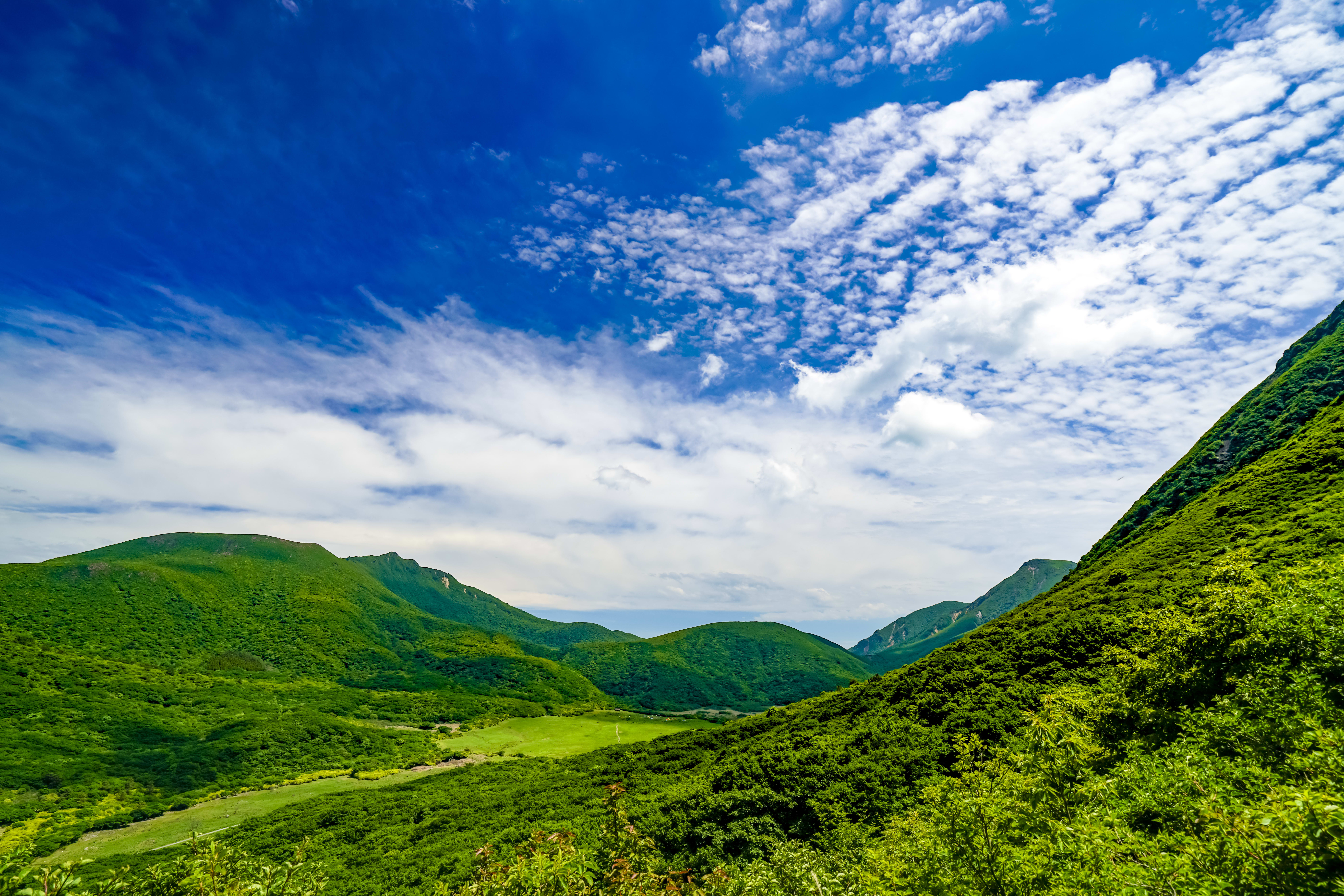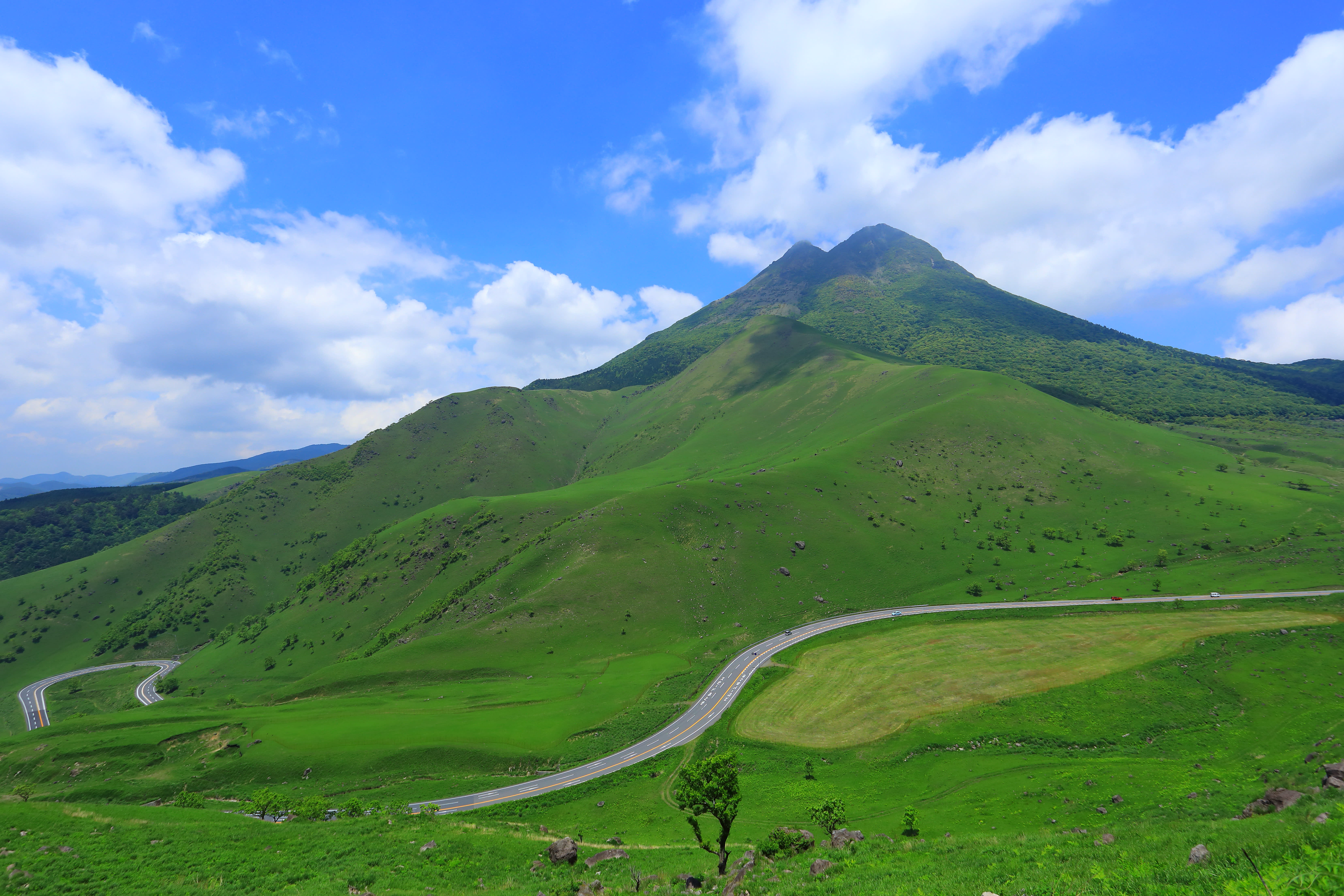Don't Miss
- Viewing the sapphire-blue crater lake of Mount Nakadake
- Going horseback riding in the Aso grasslands
- Trekking through the beautiful Kuju mountain range
- Globe thistles and star lilies in Tadewara Marsh
Aso-Kuju National Park is home to volcanic peaks and fantastically shaped terrain, steamy hot springs, virgin forests and vast pastoral grasslands filled with flowers. Go horseback riding, scale mountains, take in the views of a sapphire-blue crater lake, explore highland marshes and soak in an open-air onsen in one of Japan’s most dynamic landscapes.
The southern part of Kyushu’s Aso-Kuju National Park is dominated by the majestic Mount Aso, composed of five peaks inside one of the world's largest calderas. The Kuju mountain range stretches across the park’s center, and to the north are two more peaks—Mount Yufu and Mount Tsurumi. In between, the terrain is made up of sweeping grasslands, highland marshes, dense forests and hot spring towns, making it an ideal spot for all kinds of activities and leisure pursuits.
Aso Caldera is one of the largest calderas in the world, spanning 18 kilometers from east to west and 25 kilometers from north to south. The five peaks of Mount Aso rise from the flat caldera floor. One of them, Mount Nakadake, is still active. Within its central crater is an acidic pool of pale turquoise blue from which smoke and steam constantly rise. Because of increased activity in recent years, it is sometimes not possible to approach the crater. Nearby is Komezuka, an almost perfect volcanic cone standing 80 meters high.
The surrounding plateau, created from volcanic ash and debris, is a stark contrast with the rocky terrain of the Aso Caldera, blanketed with pastoral grasslands. The area is perfect for raising horses and the indigenous Akaushi cattle, prized for their rich-tasting, marbled meat. While you’re in the area, sample the local milk and cheese or go horseback riding.
If you want to know more about the titanic forces that shaped the Aso volcanoes and Nakadake Crater, stop by the Aso Volcano Museum. For an exhilarating way to familiarize yourself with the landscape, sign up for a cycling tour.
The five peaks of Mount Aso are said to resemble a sleeping Buddha. A great place to observe them and the Aso area’s expansive grasslands is the Daikanbo Lookout. For a loftier aerial view, hop into a hot air balloon or helicopter, or try tandem paragliding with an experienced instructor.
Further south, you’ll find the Shirakawa Headspring, a cluster of springs that serve as a water source for the Shirakawa River. The waters from these springs are considered some of the best tasting in Japan, so don't be shy about having a drink.

The Kuju Mountains stretch through the center of Aso-Kuju National Park. Mount Nakadake (1,791 m) is the highest point on the island of Kyushu. The area has an extensive number of hiking trails and is particularly popular in early summer when azaleas are in full bloom. The two trailheads at Makinoto Pass and the Chojabaru Visitor Center will take you to Kuju’s main peaks—Nakadake, Kuju and Hossho.
Tadewara and Bogatsuru are two marshes at the edge of the Kuju mountain range. Both are wetlands recognized as Ramsar Sites of International Importance, inhabited by a variety of rare plants like shimuraninjin (Pterygopleurum neurophyllum) and prairie sphagnum (Sphagnum palustre), along with animals such as golden eagles, Hodgson’s hawk-eagles and peregrine falcons. At Tadewara Marsh there is a network of elevated cedar boardwalks designed to protect the delicate ecosystem. Look out for globe thistles and star lilies in the summer.
North of the marshes is Kurodake Nature Forest, a dense grove of beech and elm trees covering the slopes of Mount Kurodake. The walking trail will take you to Oike Springs, whose powerful flow produces 14 tons of water every minute.
Another fascinating walking course takes you around Komatsujigoku, which is full of steaming mini-craters and bubbling, sulfurous ponds. You can buy eggs and boil them in the waters for a quick snack.
The serene highlands and grasslands of Taketa, where you can try a variety of equestrian activities, also sit in the shadow of the Kuju Mountains.

Mount Yufu and Mount Tsurumi cap the northern part of Aso-Kuju National Park. Mount Tsurumi has been revered as a sacred mountain since ancient times. The summit is accessible by ropeway or on foot, and houses a number of statues and shrines. On clear days, you can enjoy panoramic views of Beppu Bay, Mount Yufu, and the Kuju Mountains from here.
The hike up Mount Yufu (1,583 m) takes about two hours. At the summit, you’ll have panoramic views of the hot spring towns of Beppu and Yufuin. After a hike, treat your weary legs to a soak in the mineral-rich hot springs at the base of the mountain.

From mid-February to March, the park’s grasslands are seared away in a controlled burn called noyaki. The practice of noyaki has been carried out for over a millennium to prevent shrubs and trees from taking over the land. This practice helps preserve the grassland for cattle and horses and gives the Aso-Kuju region its unique landscape. The Aso Fire Festival, known as Hifuri Shinji in Japanese, began in 1984 and is held every year in mid-March.